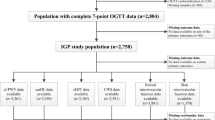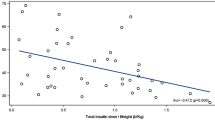Abstract
Introduction
Type 2 diabetes (T2D), the fastest growing pandemic, is typically accompanied by vascular complications. A central hallmark of both T2D and vascular disease is insulin resistance which causes impaired glucose transport and vasoconstriction concomitantly. Those with cardiometabolic disease display greater variation in central hemodynamics and arterial elasticity, both potent predictors of cardiovascular morbidity and mortality, which may be exacerbated by concomitant hyperglycemia and hyperinsulinemia during glucose testing. Thus, elucidating central and arterial responses to glucose testing in those with T2D may identify acute vascular pathophysiologies triggered by oral glucose loading.
Aim
This study compared hemodynamics and arterial stiffness to an oral glucose challenge (OGC: 50g glucose) between individuals with and without T2D. 21 healthy (48 ± 10 years) and 20 participants with clinically diagnosed T2D and controlled hypertension (52 ± 8 years) were tested.
Methods
Hemodynamics and arterial compliance were assessed at baseline, and 10, 20, 30, 40, 50, and 60 min post-OGC.
Results
Heart rate increased between 20 and 60 post-OGC in both groups (p < 0.05). Central systolic blood pressure (SBP) decreased in the T2D group between 10 and 50 min post-OGC while central diastolic blood pressure (DBP) decreased in both groups from 20 to 60 post-OGC. Central SBP decreased in T2D between 10 and 50 min post-OGC and central DBP decreased in both groups between 20 and 60 min post-OGC. Brachial SBP decreased between 10 and 50 min in healthy participants, whereas both groups displayed decreases in brachial DBP between 20 and 60 min post-OGC. Arterial stiffness was unaffected.
Conclusions
An OGC alters central and peripheral blood pressure in healthy and T2D participants similarly with no changes in arterial stiffness.
Similar content being viewed by others
Availability of Data and Materials
The datasets generated during and/or analyzed during the current study are available from the corresponding author on reasonable request.
REFERENCES
Kim JA, Montagnani M, Koh KK, Quon MJ. Reciprocal relationships between insulin resistance and endothelial dysfunction: molecular and pathophysiological mechanisms. Circulation. 2006;113(15):1888–904.
Meza CA, La Favor JD, Kim DH, Hickner RC. Endothelial dysfunction: is there a hyperglycemia-induced imbalance of NOX and NOS? Int J Mol Sci. 2019;20(15):3775.
Baron AD, Tarshoby M, Hook G, Lazaridis EN, Cronin J, Johnson A, et al. Interaction between insulin sensitivity and muscle perfusion on glucose uptake in human skeletal muscle: evidence for capillary recruitment. Diabetes. 2000;49(5):768–74.
Roberts-Thomson KM, Betik AC, Premilovac D, Rattigan S, Richards SM, Ross RM, et al. Postprandial microvascular blood flow in skeletal muscle: Similarities and disparities to the hyperinsulinaemic-euglycaemic clamp. Clin Exp Pharmacol Physiol. 2020;47(4):725–37.
Urbina EM, Kimball TR, Khoury PR, Daniels SR, Dolan LM. Increased arterial stiffness is found in adolescents with obesity or obesity-related type 2 diabetes mellitus. J Hypertens. 2010;28(8):1692–8.
Stehouwer CD, Henry RM, Ferreira I. Arterial stiffness in diabetes and the metabolic syndrome: a pathway to cardiovascular disease. Diabetologia. 2008;51(4):527–39.
Russell RD, Hu D, Greenaway T, Blackwood SJ, Dwyer RM, Sharman JE, et al. Skeletal muscle microvascular-linked improvements in glycemic control from resistance training in individuals with type 2 diabetes. Diabetes Care. 2017;40(9):1256–63.
Hu D, Remash D, Russell RD, Greenaway T, Rattigan S, Squibb KA, et al. Impairments in adipose tissue microcirculation in type 2 diabetes mellitus assessed by real-time contrast-enhanced ultrasound. Circ Cardiovasc Imaging. 2018;11(4): e007074.
Gallo G, Volpe M, Savoia C. Endothelial dysfunction in hypertension: current concepts and clinical implications. Front Med. 2021;8: 798958.
Assmann G, Schulte H. The Prospective Cardiovascular Münster (PROCAM) study: prevalence of hyperlipidemia in persons with hypertension and/or diabetes mellitus and the relationship to coronary heart disease. Am Heart J. 1988;116(6 Pt 2):1713–24.
Eschwège E. The dysmetabolic syndrome, insulin resistance and increased cardiovascular (CV) morbidity and mortality in type 2 diabetes: aetiological factors in the development of CV complications. Diabetes Metab. 2003;29(4 Pt 2):6s19-27.
De Nigris V, Pujadas G, La Sala L, Testa R, Genovese S, Ceriello A. Short-term high glucose exposure impairs insulin signaling in endothelial cells. Cardiovasc Diabetol. 2015;14:114.
Franklin SS, Khan SA, Wong ND, Larson MG, Levy D. Is pulse pressure useful in predicting risk for coronary heart Disease? The Framingham heart study. Circulation. 1999;100(4):354–60.
Cholesterol, diastolic blood pressure, and stroke: 13,000 strokes in 450,000 people in 45 prospective cohorts. Prospective studies collaboration. Lancet (London, England). 1995;346(8991-8992):1647-53. https://pubmed.ncbi.nlm.nih.gov/8551820/
Cockcroft JR. Exploring vascular benefits of endothelium-derived nitric oxide. Am J Hypertens. 2005;18(12 Pt 2):177s-s183.
Schram MT, Kostense PJ, Van Dijk RA, Dekker JM, Nijpels G, Bouter LM, et al. Diabetes, pulse pressure and cardiovascular mortality: the Hoorn Study. J Hypertens. 2002;20(9):1743–51.
Whiteley L, Padmanabhan S, Hole D, Isles C. Should diabetes be considered a coronary heart disease risk equivalent?: results from 25 years of follow-up in the Renfrew and Paisley survey. Diabetes Care. 2005;28(7):1588–93.
Lee HY, Oh BH. Aging and arterial stiffness. Circ J. 2010;74(11):2257–62.
Zieman SJ, Melenovsky V, Kass DA. Mechanisms, pathophysiology, and therapy of arterial stiffness. Arterioscler Thromb Vasc Biol. 2005;25(5):932–43.
Han SH, Quon MJ, Koh KK. Reciprocal relationships between abnormal metabolic parameters and endothelial dysfunction. Curr Opin Lipidol. 2007;18(1):58–65.
Roman MJ, Devereux RB, Kizer JR, Okin PM, Lee ET, Wang W, et al. High central pulse pressure is independently associated with adverse cardiovascular outcome the strong heart study. J Am Coll Cardiol. 2009;54(18):1730–4.
Vlachopoulos C, Aznaouridis K, Stefanadis C. Prediction of cardiovascular events and all-cause mortality with arterial stiffness: a systematic review and meta-analysis. J Am Coll Cardiol. 2010;55(13):1318–27.
Weber T, Auer J, O’Rourke Michael F, Kvas E, Lassnig E, Berent R, et al. Arterial stiffness, wave reflections, and the risk of coronary artery disease. Circulation. 2004;109(2):184–9.
Taniwaki H, Kawagishi T, Emoto M, Shoji T, Kanda H, Maekawa K, et al. Correlation between the intima-media thickness of the carotid artery and aortic pulse-wave velocity in patients with type 2 diabetes. Vessel wall properties in type 2 diabetes. Diabetes Care. 1999;22(11):1851.
Association AD. Diagnosis and classification of diabetes mellitus. Diabetes Care. 2013;37(Supplement_1):S81–90.
Arun KH, Kaul CL, Ramarao P. High glucose concentration augments angiotensin II mediated contraction via AT1 receptors in rat thoracic aorta. Pharmacol Res. 2004;50(6):561–8.
Hink U, Li H, Mollnau H, Oelze M, Matheis E, Hartmann M, et al. Mechanisms underlying endothelial dysfunction in diabetes mellitus. Circ Res. 2001;88(2):E14-22.
Zamami Y, Takatori S, Yamawaki K, Miyashita S, Mio M, Kitamura Y, et al. Acute hyperglycemia and hyperinsulinemia enhance adrenergic vasoconstriction and decrease calcitonin gene-related peptide-containing nerve-mediated vasodilation in pithed rats. Hypertens Res. 2008;31(5):1033–44.
Russell RD, Hu D, Greenaway T, Sharman JE, Rattigan S, Richards SM, et al. Oral glucose challenge impairs skeletal muscle microvascular blood flow in healthy people. Am J Physiol Endocrinol Metab. 2018;315(2):E307–15.
Monnard CR, Fellay B, Scerri I, Grasser EK. Substantial inter-subject variability in blood pressure responses to glucose in a healthy, non-obese population. Front Physiol. 2017;8:507.
Higaki T, Kurisu S, Watanabe N, Ikenaga H, Shimonaga T, Iwasaki T, et al. Reduction of central blood pressure in response to oral glucose loading is blunted in patients with diabetes mellitus. Am J Hypertens. 2016;29(3):357–64.
Hashizume M, Kinami S, Sakurai K, Izawa KP, Shiotani H. Postprandial blood pressure decrease in patients with type 2 diabetes and mild or severe cardiac autonomic dysfunction. Int J Environ Res Public Health. 2019;16(5):812.
Russell RD, Kraemer RR, Nelson AG. Metabolic dysfunction in diabetic offspring: deviations in metabolic flexibility. Med Sci Sports Exerc. 2013;45(1):8–15.
Keske MA, Clerk LH, Price WJ, Jahn LA, Barrett EJ. Obesity blunts microvascular recruitment in human forearm muscle after a mixed meal. Diabetes Care. 2009;32(9):1672–7.
Funada J, Takata Y, Hashida H, Matsumoto Y, Sato S, Hiasa G, et al. Dysfunctional central hemodynamic regulation after daily meal intake in metabolic syndrome. Atherosclerosis. 2010;210(1):268–73.
Mutter AF, Fullwood L, Hawkins M, Cowley AJ. The integrated response of the cardiovascular system to food. Digestion. 1992;52(3–4):184–93.
Goldstein IB, Shapiro D. Postprandial ambulatory blood pressure and heart rate effects in healthy elderly adults. Int J Psychophysiol. 1996;21(2–3):91–5.
Hollekim-Strand SM, Malmo V, Follestad T, Wisløff U, Ingul CB. Fast food increases postprandial cardiac workload in type 2 diabetes independent of pre-exercise: a pilot study. Nutr J. 2015;14:79.
Abdullah E, Lee JB, Notay K, Millar PJ. Postprandial superior mesenteric artery blood flow is related to changes in peripheral pulse wave harmonics and heart rate: implications for wearable technology? J Appl Physiol (Bethesda, Md: 1985). 2021;131(2):681–8.
Ahuja KD, Robertson IK, Ball MJ. Acute effects of food on postprandial blood pressure and measures of arterial stiffness in healthy humans. Am J Clin Nutr. 2009;90(2):298–303.
Taylor JL, Curry TB, Matzek LJ, Joyner MJ, Casey DP. Acute effects of a mixed meal on arterial stiffness and central hemodynamics in healthy adults. Am J Hypertens. 2014;27(3):331–7.
Gordin D, Rönnback M, Forsblom C, Heikkilä O, Saraheimo M, Groop PH. Acute hyperglycaemia rapidly increases arterial stiffness in young patients with type 1 diabetes. Diabetologia. 2007;50(9):1808–14.
Westerbacka J, Wilkinson I, Cockcroft J, Utriainen T, Vehkavaara S, Yki-Järvinen H. Diminished wave reflection in the aorta. A novel physiological action of insulin on large blood vessels. Hypertension (Dallas, Tex : 1979). 1999;33(5):1118–22.
Tamminen M, Westerbacka J, Vehkavaara S, Yki-Järvinen H. Insulin-induced decreases in aortic wave reflection and central systolic pressure are impaired in type 2 diabetes. Diabetes Care. 2002;25(12):2314–9.
Fernberg U, Fernström M, Hurtig-Wennlöf A. Arterial stiffness is associated to cardiorespiratory fitness and body mass index in young Swedish adults: the Lifestyle, Biomarkers, and Atherosclerosis study. Eur J Prev Cardiol. 2017;24(17):1809–18.
Shepherd JA, Ng BK, Sommer MJ, Heymsfield SB. Body composition by DXA. Bone. 2017;104:101–5.
Strasser B, Arvandi M, Pasha E, Haley A, Stanforth P, Tanaka H. Abdominal obesity is associated with arterial stiffness in middle-aged adults. Nutr Metab Cardiovasc Dis. 2015;25(5):495–502.
Ferreira I, Snijder MB, Twisk JW, van Mechelen W, Kemper HC, Seidell JC, et al. Central fat mass versus peripheral fat and lean mass: opposite (adverse versus favorable) associations with arterial stiffness? The Amsterdam Growth and Health Longitudinal Study. J Clin Endocrinol Metab. 2004;89(6):2632–9.
Funding
The authors declare no specific funding for this work.
Author information
Authors and Affiliations
Contributions
RDR was responsible for the study design, obtaining human ethics approval, recruiting and testing participants, and manuscript preparation. YLT contributed to data collection and analysis, and manuscript preparation. SM and GAF contributed to participant recruiting and testing, and manuscript preparation.
Corresponding author
Ethics declarations
Conflict of Interest
The authors declare there are no competing interests.
Rights and permissions
Springer Nature or its licensor (e.g. a society or other partner) holds exclusive rights to this article under a publishing agreement with the author(s) or other rightsholder(s); author self-archiving of the accepted manuscript version of this article is solely governed by the terms of such publishing agreement and applicable law.
About this article
Cite this article
Tai, Y.L., Marupudi, S., Figueroa, G.A. et al. Hemodynamics and Arterial Stiffness in Response to Oral Glucose Loading in Individuals with Type II Diabetes and Controlled Hypertension. High Blood Press Cardiovasc Prev 30, 175–181 (2023). https://doi.org/10.1007/s40292-023-00569-2
Received:
Accepted:
Published:
Issue Date:
DOI: https://doi.org/10.1007/s40292-023-00569-2




